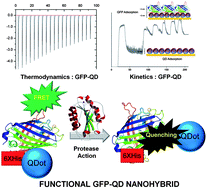Bio-nanohybrids of quantum dots and photoproteins facilitating strong nonradiative energy transfer†
Abstract
Utilization of light is crucial for the life cycle of many organisms. Also, many organisms can create light by utilizing chemical energy emerged from biochemical reactions. Being the most important structural units of the organisms,


 Please wait while we load your content...
Please wait while we load your content...